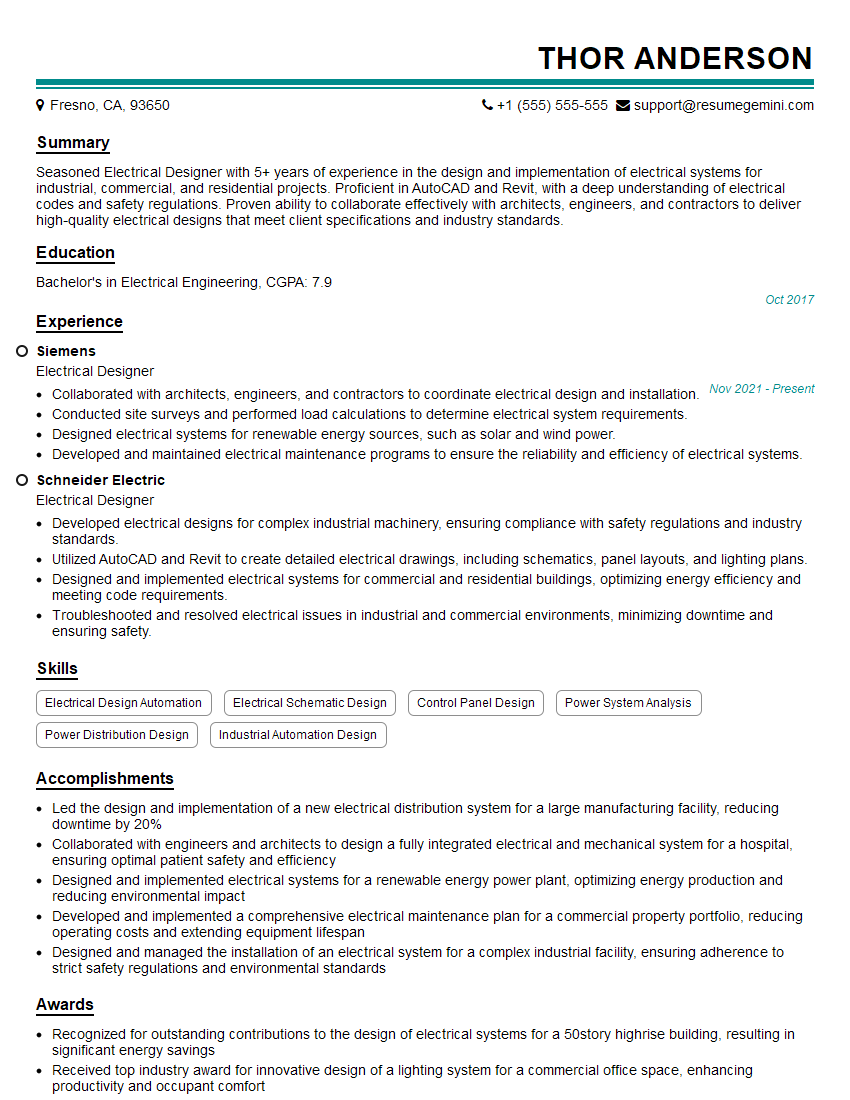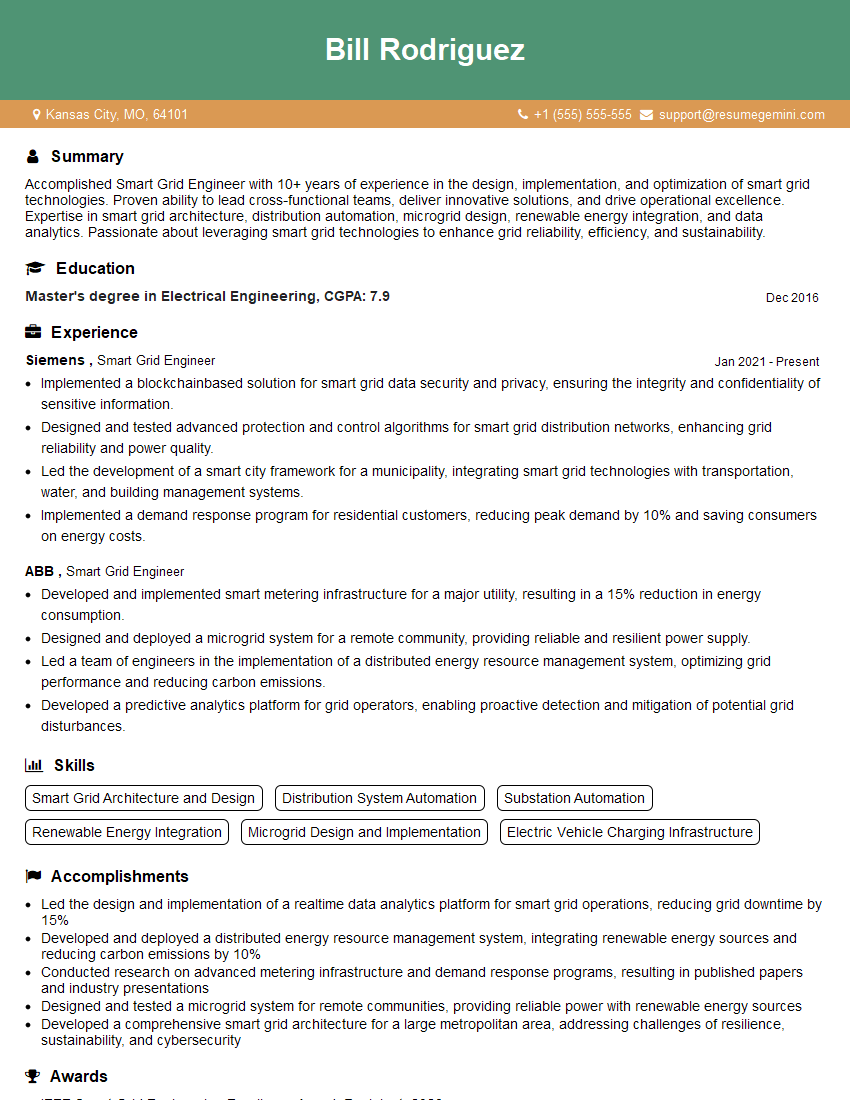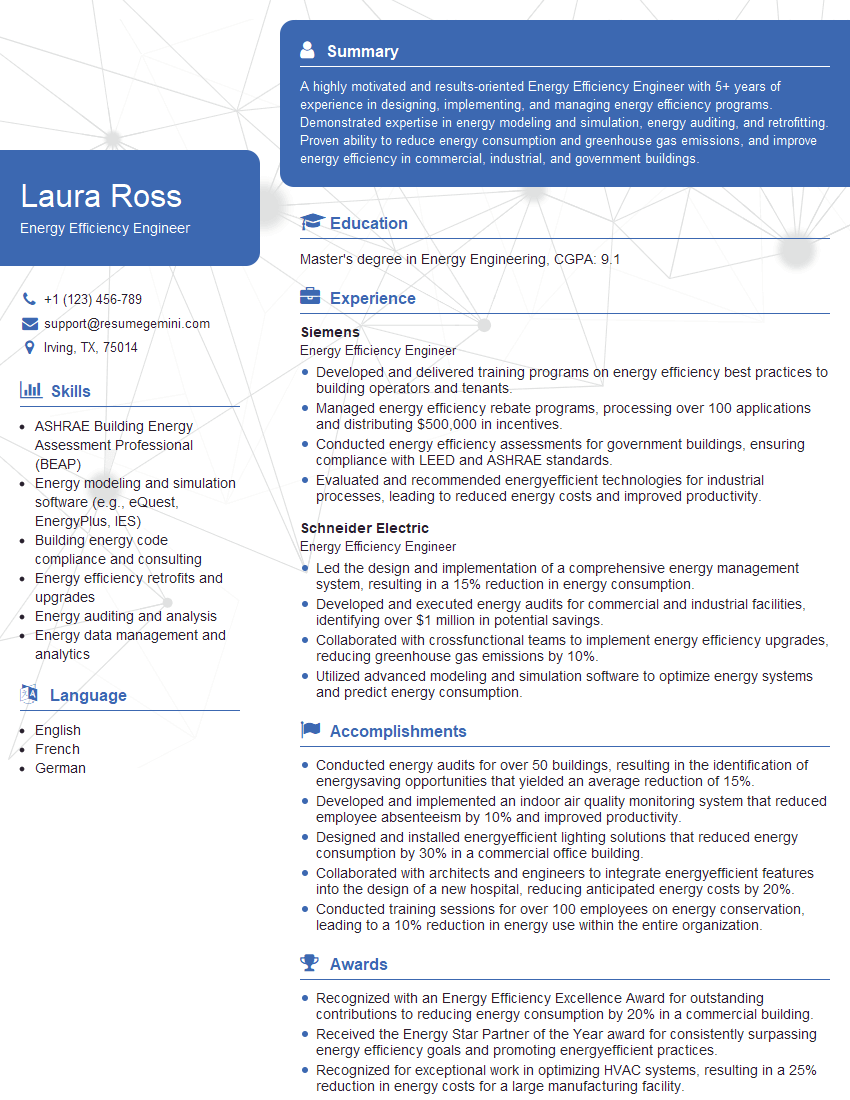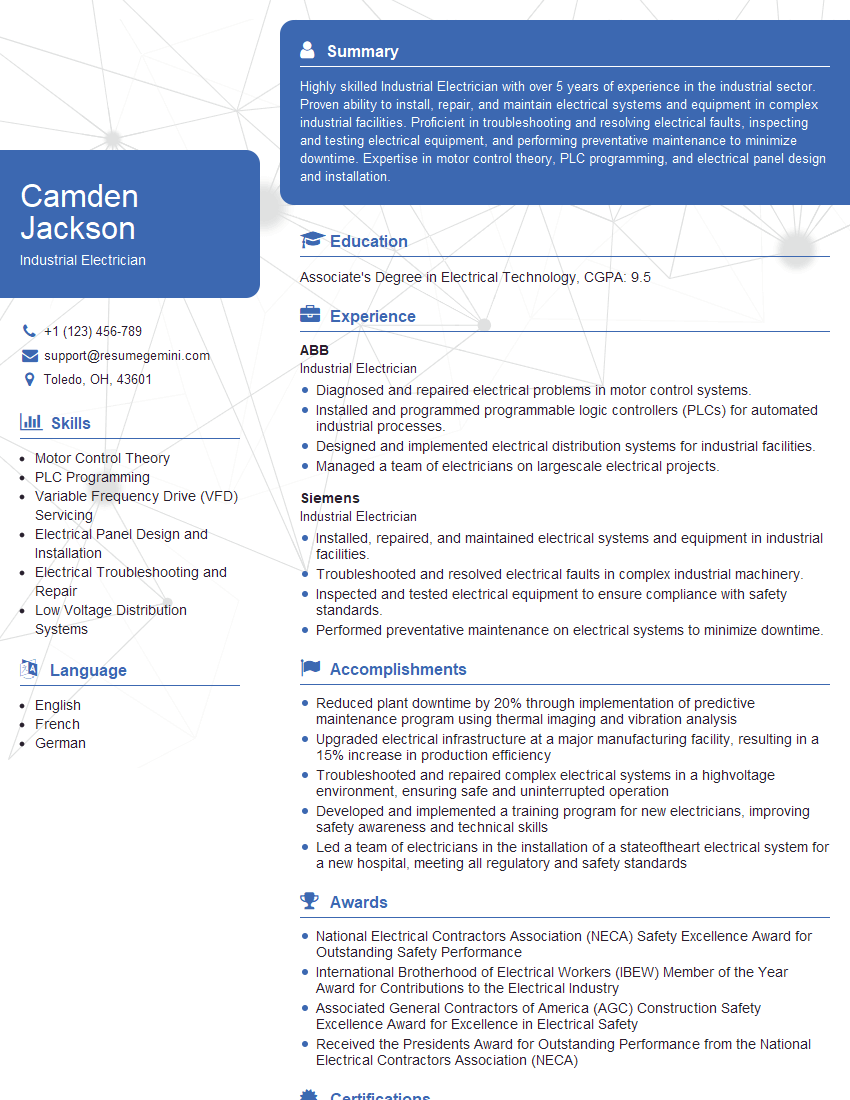Unlock your full potential by mastering the most common Power Factor Correction and Energy Efficiency interview questions. This blog offers a deep dive into the critical topics, ensuring you’re not only prepared to answer but to excel. With these insights, you’ll approach your interview with clarity and confidence.
Questions Asked in Power Factor Correction and Energy Efficiency Interview
Q 1. Explain the concept of power factor and its significance.
Power factor is the ratio of real power (kW) used by a load to the apparent power (kVA) drawn from the supply. It essentially represents how efficiently the electrical power is utilized. A power factor of 1.0 indicates perfect efficiency, meaning all the apparent power is converted into useful work. A low power factor (less than 1.0) implies that a significant portion of the apparent power is wasted as reactive power, leading to increased energy costs and system inefficiencies. Imagine trying to fill a bucket (useful work) with a leaky hose (reactive power). The bucket still fills, but you’re wasting water (energy) along the way. This is analogous to a low power factor situation.
Q 2. What are the causes of low power factor?
Low power factors are primarily caused by inductive loads, such as motors, transformers, and fluorescent lighting. These loads consume reactive power, which doesn’t perform any useful work but still flows through the system, increasing the current demand. Other factors contributing to a low power factor include undersized or poorly maintained equipment and unbalanced three-phase loads. For instance, a large factory with many induction motors operating simultaneously will generally exhibit a lower power factor compared to a facility with primarily resistive loads like incandescent lighting.
Q 3. Describe different methods for power factor correction.
Several methods exist for power factor correction, the most common being the use of capacitors. Capacitors provide leading reactive power, which compensates for the lagging reactive power consumed by inductive loads. Other methods include using synchronous motors (which can operate at leading power factor), power factor correction equipment (PFC units) containing a bank of capacitors, and using electronic power factor correction techniques in modern drives and power supplies. The optimal method depends on factors such as the size and type of load, the desired level of correction, and cost considerations.
Q 4. How do power factor correction capacitors work?
Power factor correction capacitors work by supplying leading reactive power to counteract the lagging reactive power drawn by inductive loads. When connected in parallel with the inductive load, the capacitor’s leading reactive current cancels out a portion of the load’s lagging reactive current. This reduces the overall reactive power demand on the supply, bringing the power factor closer to unity. Think of it as a balancing act: the capacitor’s reactive power ‘neutralizes’ the load’s reactive power, leaving more of the apparent power available for useful work. The size of the capacitor determines the amount of reactive power it can provide.
Q 5. What are the advantages and disadvantages of using capacitors for power factor correction?
Advantages of using capacitors for PFC:
- Cost-effective solution for improving power factor.
- Relatively simple to install and maintain.
- Can improve system efficiency and reduce energy losses.
- Reduces the load on the electrical system, potentially delaying the need for upgrades.
Disadvantages of using capacitors for PFC:
- Can cause resonance issues if not properly sized and installed.
- May require regular maintenance and replacement.
- Can be susceptible to damage from voltage surges or overcurrents.
- May not be suitable for highly variable loads.
Q 6. Explain the role of power factor correction in reducing energy costs.
Power factor correction directly reduces energy costs by minimizing the reactive power drawn from the supply. Utilities often charge penalties for low power factors because they represent wasted energy and increased strain on the electrical grid. By correcting the power factor, you reduce the amount of apparent power needed to deliver the same amount of real power, resulting in lower electricity bills. Imagine paying for a larger pizza than you need because some of the slices are inedible – a low power factor is like paying for that extra, unusable pizza.
Q 7. How do you determine the appropriate size of power factor correction capacitors?
Determining the appropriate size of power factor correction capacitors involves several steps: First, measure the existing power factor and the total kVA demand of the load. Then, calculate the required reactive power correction using power factor correction formulas and tables, readily available in power systems handbooks. This calculation takes into account the desired target power factor and the load’s characteristics. Finally, select capacitors with a combined reactive power rating that matches or exceeds the calculated requirement. It’s crucial to consult with a qualified electrical engineer to ensure proper sizing and safe installation of the capacitors to avoid potential problems like resonance.
Q 8. What are the safety considerations when installing power factor correction capacitors?
Installing power factor correction (PFC) capacitors involves significant safety considerations due to the high voltages and currents involved. Improper installation can lead to electrical shocks, fires, and equipment damage. Here’s a breakdown of key safety precautions:
- Proper Disconnection: Always ensure the power supply is completely disconnected and locked out/tagged out before commencing any work on the electrical system. Never rely solely on circuit breakers; physically lock them out to prevent accidental re-energization.
- Grounding and Bonding: Thoroughly ground all equipment and tools to prevent static electricity buildup and ensure a safe path for fault currents. Proper bonding ensures that all conductive parts are at the same potential.
- Personal Protective Equipment (PPE): Use appropriate PPE, including safety glasses, insulated gloves, and arc-flash protective clothing, depending on the voltage level. Higher voltages demand more robust protective gear.
- Capacitor Discharge: Before handling capacitors, always discharge them completely using a suitable resistor to eliminate any residual charge. Never assume a capacitor is fully discharged; always verify using a voltage meter.
- Correct Capacitor Selection and Installation: Select capacitors with the correct voltage and kVAR rating for the application. Ensure proper mounting and connection to prevent overheating and potential failures. Follow manufacturer’s instructions precisely.
- Short Circuit Protection: Install appropriate protective devices such as fuses or circuit breakers to prevent damage in case of short circuits or overcurrents.
- Coordination with Other Equipment: Ensure that the PFC system is properly coordinated with other electrical equipment to prevent resonance and instability. This often involves detailed calculations and system analysis.
- Regular Inspection and Maintenance: Periodically inspect the PFC system for signs of damage, overheating, or loose connections. Regular maintenance helps to ensure the safety and efficiency of the system.
Ignoring these safety measures can lead to serious consequences. A simple mistake, like failing to discharge a capacitor, can result in a fatal electric shock. Always prioritize safety when working with high-voltage equipment.
Q 9. Describe different types of power factor correction equipment.
Several types of power factor correction equipment are available, each with its own advantages and disadvantages. The choice depends on factors like the size of the installation, the level of harmonic distortion, and the budget.
- Fixed Capacitors: These are the simplest and most common type, offering a fixed amount of reactive power compensation. They are suitable for applications with relatively stable loads.
- Switched Capacitor Banks: These banks consist of multiple capacitors that can be switched on or off depending on the load demand. This allows for more precise power factor correction and improves efficiency compared to fixed capacitors.
- Automatic Power Factor Correction (APFC) Systems: These systems automatically adjust the amount of reactive power compensation based on the load demand. They typically use microprocessors to monitor the power factor and control the switching of capacitors, providing optimized correction and minimizing energy waste.
- Static Synchronous Compensators (STATCOMs): These advanced systems use power electronics to provide fast and precise reactive power compensation. They are particularly useful in applications with rapidly changing loads or high harmonic distortion.
- Rotary Synchronous Condensers: These are large, rotating machines that provide reactive power compensation. They are less common now due to their higher maintenance requirements compared to static solutions but can handle higher harmonic distortion levels.
For example, a small commercial building might use fixed capacitors for its relatively constant lighting load. A large industrial facility with fluctuating loads, such as a factory with varying motor operation, would likely benefit from an APFC system for dynamic correction.
Q 10. How do you measure power factor?
Power factor (PF) is measured using a power meter capable of measuring real power (kW), apparent power (kVA), and reactive power (kVAR). The power factor is calculated as the ratio of real power to apparent power:
Power Factor (PF) = Real Power (kW) / Apparent Power (kVA)
Real power is the actual power consumed by the load and performs useful work. Apparent power is the total power supplied to the load, including both real and reactive power. Reactive power is the power that flows back and forth in the circuit without performing useful work. A lower power factor indicates a higher proportion of reactive power.
Modern power meters directly display the power factor. Alternatively, you can manually calculate it using the formula above, obtained from the individual kW and kVA readings. For instance, if a load consumes 10 kW and draws 12.5 kVA, the power factor is 10 kW / 12.5 kVA = 0.8. A power factor of 1 represents perfect power factor.
Q 11. What are harmonic distortions and their impact on power factor correction?
Harmonic distortions are non-linear distortions in the sinusoidal waveform of the power supply. They’re caused by non-linear loads such as rectifiers, variable speed drives, and switch-mode power supplies. These distortions produce harmonic currents and voltages at multiples of the fundamental frequency (usually 50Hz or 60Hz).
Harmonic distortions significantly impact power factor correction because they increase the total harmonic distortion (THD) of the current waveform. This increased THD can lead to several problems:
- Increased heating in equipment: Harmonic currents cause extra losses in transformers, cables, and other electrical equipment.
- Reduced efficiency of PFC capacitors: Capacitors are not designed to handle significant harmonic currents; this will lead to their early failure.
- Malfunctioning of sensitive electronic equipment: Harmonic distortions can interfere with the proper operation of sensitive electronic devices.
- Resonance problems: Harmonics can cause resonance in the power system, leading to instability and potential damage.
Therefore, when designing a power factor correction system, it is crucial to consider the harmonic content of the load. This often involves using harmonic filters or selecting PFC equipment specifically designed to mitigate harmonic effects. Ignoring harmonic distortion can compromise the effectiveness and longevity of the PFC system.
Q 12. Explain the concept of kVAR and its relation to power factor.
kVAR stands for kilovolt-ampere reactive. It’s a unit of reactive power, which is the power that oscillates back and forth in an AC circuit without performing any useful work. Reactive power is mainly caused by inductive loads like motors and transformers.
The relationship between kVAR and power factor is inversely proportional. A high reactive power (kVAR) indicates a low power factor, while a low reactive power suggests a high power factor. Imagine a water pump: kW is the actual water pumped, kVAR is the energy lost in the pipeline due to friction, and kVA is the total energy consumed by the pump.
Power factor correction aims to reduce the kVAR component, bringing the power factor closer to 1.0. This improves efficiency by reducing the amount of reactive power flowing in the system, thus reducing the energy wasted.
Q 13. How do you calculate the required kVAR for power factor correction?
Calculating the required kVAR for power factor correction involves determining the current reactive power and the desired power factor. Here’s a step-by-step approach:
- Measure the existing power factor (PF) and the real power (kW) using a power meter.
- Calculate the existing apparent power (kVA) using the formula:
kVA = kW / PF - Calculate the existing reactive power (kVAR) using the formula:
kVAR = √(kVA² - kW²) - Determine the desired power factor (PFdesired). This value is usually set between 0.95 and 0.99.
- Calculate the required apparent power (kVAdesired) to achieve the desired power factor:
kVAdesired = kW / PFdesired - Calculate the required reactive power (kVARdesired) at the desired power factor:
kVARdesired = √(kVAdesired² - kW²) - Calculate the required kVAR correction (ΔkVAR):
ΔkVAR = kVAR - kVARdesired
This ΔkVAR represents the amount of reactive power compensation needed to achieve the desired power factor. This value then guides the selection of appropriately sized power factor correction capacitors.
Example: If a load consumes 10 kW with a power factor of 0.7, and we desire a power factor of 0.95, the calculations will reveal the necessary kVAR correction needed.
Q 14. What is the difference between leading and lagging power factor?
The terms ‘leading’ and ‘lagging’ power factor refer to the phase relationship between voltage and current in an AC circuit.
- Lagging Power Factor: This occurs when the current lags behind the voltage. This is typical in inductive loads (motors, transformers, inductors) which require a magnetic field to operate. This situation consumes reactive power which is useless and should be reduced.
- Leading Power Factor: This happens when the current leads the voltage. This is usually associated with capacitive loads (capacitors). The capacitor’s ability to store and discharge energy reduces the reactive power demand of the system and improves the power factor.
In most industrial settings, we encounter lagging power factors due to the prevalence of inductive loads. Power factor correction aims to counteract this lagging power factor by adding capacitive reactance to the system, shifting the current closer in phase with the voltage, and ultimately making the power factor closer to unity (1).
Q 15. How does power factor correction impact the efficiency of electrical equipment?
Power factor correction (PFC) significantly impacts the efficiency of electrical equipment by reducing energy losses. Imagine electricity as water flowing through a pipe. The voltage is the pressure, and the current is the flow rate. A low power factor means the current isn’t perfectly in sync with the voltage; it’s like the water flowing in bursts instead of a smooth stream. This inefficiency leads to higher current draw for the same amount of actual work. PFC improves this sync, reducing the wasted current and increasing overall efficiency. This translates to less heat generated, lower operational costs, and a longer lifespan for equipment. For example, a motor operating at a low power factor (e.g., 0.7) will draw more current than one operating at a high power factor (e.g., 0.95) to deliver the same mechanical power, resulting in increased energy consumption and higher operating temperatures.
Career Expert Tips:
- Ace those interviews! Prepare effectively by reviewing the Top 50 Most Common Interview Questions on ResumeGemini.
- Navigate your job search with confidence! Explore a wide range of Career Tips on ResumeGemini. Learn about common challenges and recommendations to overcome them.
- Craft the perfect resume! Master the Art of Resume Writing with ResumeGemini’s guide. Showcase your unique qualifications and achievements effectively.
- Don’t miss out on holiday savings! Build your dream resume with ResumeGemini’s ATS optimized templates.
Q 16. Describe the benefits of power factor correction in industrial settings.
In industrial settings, the benefits of PFC are substantial. Reduced energy costs are the most immediate advantage. Industries with large motor loads (e.g., manufacturing, mining) can see a significant drop in their electricity bills. Lower current draw also reduces stress on electrical infrastructure, including cables, transformers, and switchgear, prolonging their lifespan and decreasing maintenance expenses. Improved voltage stability further ensures the reliable operation of sensitive equipment. For example, a steel mill using massive induction motors could see energy savings of 10-20% by implementing PFC. This translates to thousands or even millions of dollars saved annually depending on the scale of operation. Increased capacity is another significant benefit – improved power factor allows the existing infrastructure to handle higher loads, delaying costly upgrades.
Q 17. What are some common challenges encountered during power factor correction implementation?
Implementing PFC isn’t always straightforward. Some common challenges include the high initial investment cost for PFC devices (capacitors or active PFC systems). Accurate power factor measurement and analysis is crucial for selecting the right size and type of correction equipment. Harmonics, which are unwanted frequencies in the current waveform, can be exacerbated by some types of PFC capacitors. Proper harmonic filtering might be necessary to mitigate this issue. Also, space limitations for installing PFC equipment, especially in older facilities, can be a constraint. Finally, coordination with the utility company is often needed to ensure that the PFC system complies with grid codes and regulations.
Q 18. How do you troubleshoot power factor correction problems?
Troubleshooting PFC problems requires a systematic approach. First, you need to accurately measure the power factor using a power analyzer. Check the capacitor banks for any faulty units; a simple visual inspection, capacitance measurement, and insulation resistance tests can help identify them. Examine the power system wiring and connections for loose connections or shorts. Check if the PFC system is correctly sized and tuned for the load. Analyse the harmonic content of the current waveform; high harmonic distortion can indicate problems with the PFC system or other equipment. Finally, review operational logs and historical data to identify any patterns or trends related to power factor issues. If needed, consult with a specialist experienced in PFC systems.
Q 19. Explain the role of power factor correction in meeting energy efficiency standards.
Power factor correction plays a vital role in meeting energy efficiency standards. Many regulations and standards, both nationally and internationally, aim to reduce energy consumption and promote sustainability. High power factors are often a requirement or contribute significantly to achieving compliance. Meeting these standards may reduce carbon emissions, lower energy costs for industries and consumers, and may result in incentives or penalties depending on the regulatory framework. For instance, many industrial facilities might be subject to penalties for low power factors, making PFC an economical and environmentally responsible necessity.
Q 20. What are some energy-saving measures beyond power factor correction?
Beyond power factor correction, several energy-saving measures significantly impact efficiency. These include using energy-efficient motors and drives with variable speed control (VFDs), optimizing equipment maintenance schedules, employing efficient lighting systems (LEDs), implementing process improvements to minimize energy-intensive operations, and investing in building insulation and optimized HVAC systems. A comprehensive energy audit can pinpoint other areas for improvement beyond just the power factor.
Q 21. How does power factor correction contribute to reducing greenhouse gas emissions?
Power factor correction contributes to reducing greenhouse gas emissions by lowering overall energy consumption. Since a substantial portion of electricity generation worldwide still relies on fossil fuels, decreasing energy demand directly translates to fewer greenhouse gases released into the atmosphere. By improving energy efficiency through PFC, industries and consumers contribute to mitigating climate change and reducing their carbon footprint. The environmental benefit is particularly pronounced when coupled with other energy-saving measures and renewable energy sources.
Q 22. Explain the importance of regular maintenance of power factor correction equipment.
Regular maintenance of power factor correction (PFC) equipment is crucial for ensuring its optimal performance and maximizing energy savings. Neglecting maintenance can lead to reduced efficiency, increased energy costs, and even equipment failure. Think of it like regular servicing for your car – essential to keep it running smoothly and prevent costly breakdowns.
Capacitor Bank Inspections: Regular visual inspections of capacitor banks are vital to identify any signs of bulging, leaking, or discoloration, indicating potential capacitor failure. These components are under significant stress and can degrade over time. Replacing faulty capacitors prevents cascading failures and maintains the desired power factor.
Cleaning and Contact Checks: Accumulated dust and dirt can impede proper heat dissipation and increase resistance, reducing the efficiency of the PFC system. Cleaning and ensuring good contact between components is essential. Loose connections can lead to arcing and safety hazards.
Monitoring and Data Analysis: Continuous monitoring of power factor, voltage, and current allows for early detection of anomalies and impending problems. Analyzing this data helps identify trends and enables predictive maintenance strategies, preventing unexpected downtime.
Calibration and Testing: Periodic calibration of measuring instruments and testing the PFC system’s performance against design specifications are essential to ensure accurate measurement and effective correction. This verifies that the system continues to meet its intended function.
For instance, in a manufacturing plant, neglecting capacitor bank maintenance could result in significant energy losses, translating to thousands of dollars annually. Regular maintenance ensures that the PFC system continues to provide the desired power factor correction, minimizing energy waste and maximizing operational efficiency.
Q 23. Describe the different types of energy audits.
Energy audits are systematic assessments of energy use within a building or facility to pinpoint areas of inefficiency and identify opportunities for improvement. They’re like a health check-up for your energy consumption, revealing where you’re losing energy and how to fix it.
Walk-Through Audits: These are the simplest, involving a visual inspection of the facility to identify readily observable energy-wasting practices and equipment. They provide a quick overview of potential areas for improvement.
Detailed Energy Audits: These more comprehensive audits involve detailed data collection and analysis, often including specialized equipment such as infrared cameras to detect thermal leaks and energy meters to precisely measure energy consumption of individual systems. They provide a much deeper understanding of energy flows and losses.
Energy Modeling Audits: These audits use sophisticated software to simulate energy consumption under various scenarios. They’re particularly useful for new construction or major renovations, helping to optimize energy efficiency in the design phase.
Commissioning Audits: These audits are performed on newly constructed or renovated facilities to verify that building systems are performing according to design specifications and energy efficiency goals. They ensure that the energy-efficient design is actually implemented.
The type of audit selected depends on the facility’s complexity, budget, and the level of detail required. A small office might benefit from a walk-through audit, while a large manufacturing plant would likely require a detailed audit.
Q 24. What are some key performance indicators (KPIs) used to measure energy efficiency?
Key Performance Indicators (KPIs) are crucial for measuring energy efficiency progress and evaluating the effectiveness of energy-saving initiatives. They provide quantifiable targets and allow for tracking performance over time.
Energy Consumption per Unit of Production (Energy Intensity): This measures how much energy is used to produce a given output (e.g., kilowatt-hours per ton of product). Lower values indicate greater efficiency.
Power Factor: This indicates how effectively electrical power is utilized. A power factor closer to 1 indicates less wasted energy.
Return on Investment (ROI) of Energy Efficiency Projects: This quantifies the financial benefits of energy-saving initiatives. A high ROI demonstrates a strong return on investment.
Greenhouse Gas Emissions (e.g., tons of CO2): This KPI tracks the environmental impact of energy consumption, highlighting progress towards sustainability goals.
Energy Cost per Square Foot: This is especially useful for building operations, comparing energy costs relative to building size.
For example, a manufacturing plant might track its energy intensity to monitor improvements in production efficiency, while a commercial building manager might focus on energy cost per square foot to benchmark against similar buildings and identify areas for improvement.
Q 25. How do you interpret energy consumption data to identify areas for improvement?
Interpreting energy consumption data requires a systematic approach to identify areas for improvement. It’s like detective work, piecing together clues to find the source of energy waste.
Data Collection and Aggregation: Gather comprehensive energy consumption data from various sources, including utility bills, smart meters, and building management systems. Consolidate this data into a readily analyzable format.
Baseline Establishment: Establish a baseline of energy consumption to provide a benchmark against which to measure improvements. This involves analyzing historical data to understand typical energy use patterns.
Trend Analysis: Analyze trends in energy consumption over time, looking for unusual spikes or consistent increases. This can highlight areas requiring immediate attention.
Correlation Analysis: Identify correlations between energy consumption and various factors, such as weather conditions, occupancy levels, and equipment operation. This helps pinpoint the root causes of energy waste.
Energy Use Intensity (EUI) Analysis: Calculate EUI for different areas or systems within the facility to pinpoint the biggest energy consumers. This allows for a focused approach to energy-saving efforts.
Data Visualization: Use charts and graphs to visualize the data and make it easier to identify patterns and anomalies. This makes the information more easily understandable and actionable.
For example, by analyzing energy consumption data, a data center manager might discover that server cooling accounts for a significant portion of their energy bill, prompting them to investigate more efficient cooling technologies.
Q 26. Explain the role of smart grid technologies in enhancing energy efficiency.
Smart grid technologies play a vital role in enhancing energy efficiency by enabling better monitoring, control, and optimization of energy distribution and consumption. Think of it as a sophisticated nervous system for the power grid, allowing for more intelligent and efficient management of energy flow.
Advanced Metering Infrastructure (AMI): Smart meters provide real-time energy consumption data, allowing for better monitoring and identification of energy waste. This enables proactive management and targeted interventions.
Demand-Side Management (DSM): Smart grid technologies allow for dynamic pricing and demand response programs, incentivizing consumers to shift their energy use to off-peak hours, reducing peak demand and overall energy consumption.
Distributed Generation (DG): Integration of renewable energy sources like solar and wind power through smart grid technologies enables more efficient distribution of locally generated energy, reducing reliance on centralized power plants.
Energy Storage Systems: Smart grid integration of energy storage systems (e.g., batteries) allows for storing excess energy during off-peak hours and utilizing it during peak demand, reducing strain on the grid and improving efficiency.
For example, a smart grid can automatically adjust street lighting based on real-time occupancy levels, reducing unnecessary energy consumption. This illustrates the power of intelligent control and optimization enabled by smart grid technologies.
Q 27. Describe your experience with energy management software and tools.
I have extensive experience with various energy management software and tools, including building automation systems (BAS), energy information systems (EIS), and specialized energy modeling software. These tools are essential for effectively managing and optimizing energy use.
Building Automation Systems (BAS): I’m proficient in using BAS platforms to monitor and control HVAC systems, lighting, and other building equipment in real-time, optimizing energy consumption and improving occupant comfort.
Energy Information Systems (EIS): I’m experienced in utilizing EIS platforms to collect, analyze, and visualize energy consumption data, identifying trends and areas for improvement. These systems provide critical insights for informed decision-making.
Energy Modeling Software: I have used energy modeling software to simulate energy performance under different scenarios, optimizing designs for maximum energy efficiency and predicting long-term energy consumption.
In one project, I utilized an EIS platform to identify a significant energy saving opportunity in a large office building’s HVAC system. By analyzing the data, I was able to pinpoint inefficiencies and recommend upgrades that resulted in a substantial reduction in energy consumption and cost.
Q 28. What are your strategies for implementing energy-saving initiatives in a large organization?
Implementing energy-saving initiatives in a large organization requires a comprehensive and phased approach, involving strategic planning, stakeholder engagement, and continuous monitoring. Think of it as a marathon, not a sprint – it requires sustained effort and commitment.
Conduct a Comprehensive Energy Audit: Begin with a thorough energy audit to identify the biggest energy consumers and areas for improvement. This provides a clear roadmap for action.
Set Clear Energy Goals and Targets: Establish specific, measurable, achievable, relevant, and time-bound (SMART) energy goals. This provides a clear direction and allows for effective monitoring of progress.
Prioritize Energy Efficiency Projects: Focus on high-impact projects with a quick return on investment (ROI). This ensures that resources are allocated effectively and results are seen quickly.
Implement Energy Management Systems: Invest in energy management systems (EMS) to monitor and control energy consumption in real-time. This provides continuous visibility and allows for proactive adjustments.
Engage Employees and Stakeholders: Educate employees about energy-saving practices and incentivize their participation. This fosters a culture of energy conservation.
Monitor and Evaluate Progress: Continuously monitor and evaluate the effectiveness of implemented initiatives, adjusting strategies as needed. This ensures that efforts remain focused and effective.
For example, in a previous role, I implemented a comprehensive energy management program that included upgrading lighting systems, improving HVAC efficiency, and educating employees on energy-saving practices. This resulted in a significant reduction in energy consumption and costs, demonstrating the effectiveness of a multi-pronged approach.
Key Topics to Learn for Power Factor Correction and Energy Efficiency Interviews
- Fundamentals of Power Factor: Understanding apparent, real, and reactive power; calculating power factor; interpreting power factor values and their implications.
- Methods of Power Factor Correction: Exploring different techniques like capacitor banks, synchronous condensers, and power factor correction equipment. Understanding their selection criteria and application in various industrial settings.
- Energy Efficiency Principles: Defining energy efficiency and its importance; analyzing energy consumption patterns; identifying opportunities for improvement in industrial and commercial applications.
- Practical Applications: Case studies illustrating power factor correction in different industries (e.g., manufacturing, data centers). Analyzing energy audits and their role in identifying energy saving measures.
- Economic Analysis of PFC: Evaluating the cost-effectiveness of implementing power factor correction systems; understanding ROI calculations and payback periods.
- Harmonics and Their Impact: Understanding harmonic distortion and its effects on power systems; methods for harmonic mitigation and filtering.
- Power System Analysis Techniques: Applying relevant analytical tools to model and solve power system problems related to power factor and energy efficiency. Familiarity with relevant software tools is beneficial.
- Legislation and Standards: Awareness of relevant energy efficiency regulations and standards (varies by region).
- Emerging Technologies: Understanding advancements in power electronics and their role in enhancing power factor correction and energy efficiency (e.g., smart grids, renewable energy integration).
Next Steps
Mastering Power Factor Correction and Energy Efficiency is crucial for career advancement in the power and energy sectors. These skills are highly sought after, leading to exciting opportunities in engineering, consulting, and energy management. To maximize your job prospects, invest time in creating a strong, ATS-friendly resume that highlights your expertise. ResumeGemini is a trusted resource to help you build a professional and impactful resume tailored to your skills and experience. We provide examples of resumes specifically designed for professionals in Power Factor Correction and Energy Efficiency to help you get started. This will significantly increase your chances of landing your dream role.
Explore more articles
Users Rating of Our Blogs
Share Your Experience
We value your feedback! Please rate our content and share your thoughts (optional).
What Readers Say About Our Blog
This was kind of a unique content I found around the specialized skills. Very helpful questions and good detailed answers.
Very Helpful blog, thank you Interviewgemini team.












